Oral Session
High-Field RF Coils & Arrays
Joint Annual Meeting ISMRM-ESMRMB & ISMRT 31st Annual Meeting • 07-12 May 2022 • London, UK

| 14:45 | 0706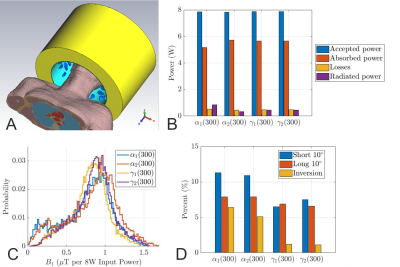 |
Design and Optimization of Transmit Arrays for MRI at 11.7T
Son Chu1, Vincent Gras2, Paul McElhinney1, Nicolas Boulant2, and Shajan Gunamony1
1Imaging Centre of Excellence, University of Glasgow, Glasgow, United Kingdom, 2University of Paris-Saclay, CEA, CNRS, BAOBAB, NeuroSpin, Gif sur Yvette, France The promise of supra-linear boost in signal-to-noise-ratio is driving the development of MRI at extremely high static field strengths, such as 10.5T and beyond. The shorter wavelengths in tissues at high Larmor frequency causes destructive interference of the electromagnetic field, resulting in image inhomogeneity and increased local specific absorption rate (SAR). An efficient transmit array is vital in this regime to optimally use the available RF power, achieve efficient excitation and operate within SAR constraints. This work presents the design and optimization of an 8-channel transmit array for MRI at 11.7T and its performance evaluation using RF pulse design simulations. |
|
| 14:57 | 0707 |
A Compact 16Tx-32Rx Geometrically Decoupled Phased Array for 11.7T MRI
Michel Luong1, Guillaume Ferrand1, Edouard Chazel2, Paul-François Gapais2,3, Vincent Gras2, Nicolas Boulant2, and Alexis Amadon2
1CEA, IRFU, Université Paris-Saclay, Gif sur Yvette, France, 2Université Paris-Saclay, CEA, CNRS, BAOBAB, NeuroSpin, Gif sur Yvette, France, 3Multiwave Imaging SAS, Marseille, France A geometrically decoupled 16Tx-32Rx RF coil has been designed for the Iseult 11.7T project. It has 16 transceive resonators and 16 receive-only loops. This peculiar architecture satisfied three major concerns: compactness-made compatibility with a local B0 shim insert, easy tuning and performance prediction. Simulations show high flip angle homogeneity in the whole brain (NRMSE<6%) with kT-points, accounting for all constraints (pulse length, SAR, power budget). Predicted global SNR in phantom with SoS reconstruction is 2.47±0.2 times higher as compared to 7T (with the commercial 8Tx-32Rx Nova coil) or equivalently, the SNR scales as B0 to the power of 1.74±0.16. |
|
| 15:09 | 0708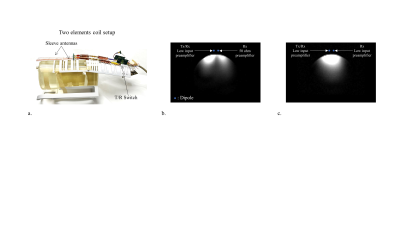 |
A novel 16-channel transmitter/32-channel receiver combined sleeve antenna and dipole array for the human whole brain imaging at 10.5 Tesla
Myung Kyun Woo1,2, Lance DelaBarre1, Matt Waks1, Russell Lagore1, Steve Jungst1, Andrea Grant1, Kamil Ugurbil1, and Gregor Adriany1
1Center for Magnetic Resonance Research, Minneapolis, MN, United States, 2Department of Electrical and Computer Engineering, Seoul National University, Seoul, Korea, Republic of
For whole brain human head imaging at 10.5 Tesla, we interlaced a 16-channel sleeve antenna transceiver with a 16-channel asymmetric dipole antenna receiver for a combined, close fitting 16-channel transmit/32 -channel receiver array. Integration of high dielectric constant material (HDC) significantly improved receiver performance in the upper brain. Simulation results indicate excellent B1 efficiency and coverage of the combined array for the whole brain imaging at 447 MHz. To further improve array performance, we developed new on-coil transmit/receive (T/R) switches capable of preamplifier decoupling. We are now in the process of building this novel closefitting 32-channel array.
|
|
| 15:21 | 0709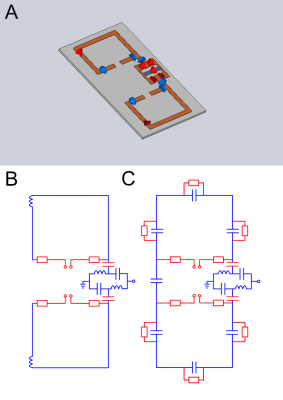 |
The Double Bent Dipole (DBD): A hybrid element designed for combined RF/B0 shimming for imaging at 10.5T
Alexander Bratch1,2, Jerahmie Radder2, Alireza Sadeghi-Tarakameh2, Gregor Adriany2, Kamil Ugurbil2, and Brian Rutt1
1Department of Radiology, Stanford University, Stanford, CA, United States, 2Center for Magnetic Resonance Research (CMRR), Department of Radiology, University of Minnesota, Minneapolis, MN, United States
In this work, we demonstrate a new double bent dipole geometry for use as a hybrid RF/B0 shimming element for 10.5T imaging, featuring two B0 shimming channels per RF channel. Initial simulations compare this element to standard dipoles and loops. Bench assessments and simulations further demonstrate excellent inter-element decoupling, and initial steps toward a 32-channel Tx/64-channel B0 array show promising results.
|
|
| 15:33 | 0710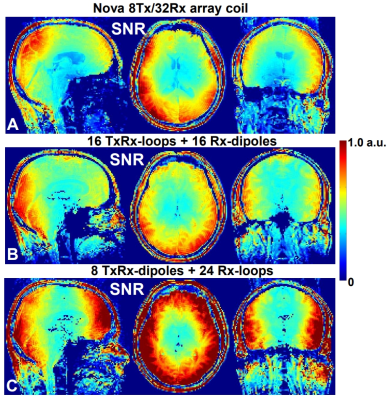 |
Novel Dipole/Loop Combined Arrays for Human Whole Brain Imaging at 7 T
Nikolai I. Avdievich1, Anton V Nikulin1,2, Loreen Ruhm 1, Arthur W Magill 3, Anke Henning4, and Klaus Scheffler1,2
1High-Field MR Center, Max Planck Institute for Biological Cybernetics, Tübingen, Germany, 2Biomedical Magnetic Resonance, University of Tübingen, Tübingen, Germany, 3Medical Physics in Radiology, German Cancer Research Center, Heidelberg, Germany, 4Advanced Imaging Research Center, University of Texas Southwestern Medical Center, Dallas, TX, United States
The advancement of clinical applications of 7T MRI depends heavily on the development of new RF coil designs. Recent works based on Ultimate Intrinsic SNR theory demonstrated that an optimal central SNR at 7T requires combining surface loops with dipole antennas. In this work, we developed and evaluated two novel 32-element 7T human head loop/dipole array designs. Both coils demonstrated superior Tx-efficiency, longitudinal coverage, and SNR in comparison to widely used commercial array coil. While the transceiver (TxRx)-dipole/receive(Rx)-loop array demonstrated best SNR, the TxRx-loop/Rx-dipole array showed the best Tx-efficiency. In addition, double-row TxRx-loop/Rx-dipole array provides 3D RF shimming capability.
|
|
| 15:45 | 0711 |
Generalized approach of quadruple or quintuple-tuned RF coil setups for metabolic MRI throughout the body at 7 Tesla
Jiying Dai1,2, Ettore Flavio Meliadò1,2, Mark Gosselink1, Catalina Arteaga2, Alexander J. E. Raaijmakers1,3, and Dennis W. J. Klomp1
1UMC Utrecht, Utrecht, Netherlands, 2Tesla Dynamic Coils B.V., Zaltbommel, Netherlands, 3Technische Universiteit Eindhoven, Eindhoven, Netherlands The 7T operating frequency of 1H and 19F RF transceivers is in far field regime, while for remaining nuclei these are in near-field regime. Consequently, the optimal setup for far field is based on antennas, while for near field these are based on loop coils. Owing to their intrinsic field orthogonality, these setups can be merged with low RF coupling and thus low penalty in efficiency as we demonstrated for a quintuple tuned head coil. Here we show that the design is generalized and can in principle be used for any body part, as demonstrated in brain, breast and extremity. |
|
| 15:57 | 0712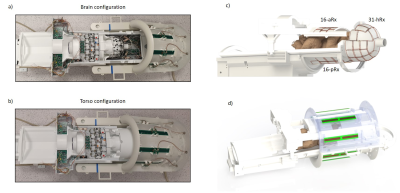 |
An integrated 64-channel receive array design for 7 Tesla head and torso MRI of young infants
Jérémie Clément1, Joseph V Hajnal1,2, and Özlem Ipek1
1Biomedical Engineering Department, School of Biomedical Engineering and Imaging Sciences, King's College London, London, United Kingdom, 2Centre for the Developing Brain, School of Biomedical Engineering and Imaging Sciences, King's College London, London, United Kingdom
7T MRI has potential for adding value in studies of infant brain and heart. In this study we introduce the first integrated high channel count receive array designed to enable both head and torso imaging of young infants at 7T. The array performance was evaluated in terms of noise correlation matrix, signal-to-noise ratio, and spatial coverage. The initial results are promising with the array providing a large coverage of the targeted regions in phantom. After further safety checking, the next step will be to conduct in-vivo studies, paving the way for future high performance infant examinations at 7T.
|
The International Society for Magnetic Resonance in Medicine is accredited by the Accreditation Council for Continuing Medical Education to provide continuing medical education for physicians.